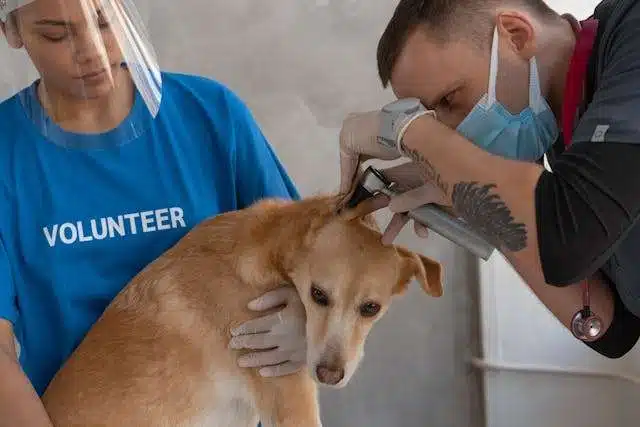You’re planning to go on vacation with your puppy, but you’re worried about flying with them for the first time. Then you’ve come to the right place if that describes you. I’m going to tell you everything you need to know so that you can fly with your puppy stress-free.
Table of Contents
ToggleWhat You will Need
You’ll need to book a pet-friendly airline and reserve your dog’s spot on the plane. You’ll need to make sure that your dog’s size and weight fit the requirements of the airline. Your dog needs to have a microchip. Your dog might need to have a health certificate for domestic flights or a passport for international flights. You’ll need a comfortable carrier bag that fits your dog and can be placed under the seat in front of you on the plane. Now, let’s talk about each of these points.
How To Know If The Airline Accepts Pet
First of all, how do you know if the airline you chose accepts pets? Well, the first thing we do when we fly with a new airline is we check their website. Now, sometimes the website isn’t very clear on whether they accept pets or not, or you can’t really find the information. So, here’s a Googling tip: open Google and type the following: site:airline.com space pets. Let me give you an example. So, let’s say you’re flying with Delta. So, you’re going to type in “site:delta.com pets.” And there you go, here are all the pages of Delta’s website that mention traveling with pets. Now, all you need to do is read the section under “carry-on pets” to find everything you need to know.
The Maximum Weight Limit For Pets

The next, step is to make sure that your dog is under the maximum weight that they accept for flights in the cabin. Every airline has a maximum weight limit for pets flying as carry-ons. Most of them usually accept dogs up to 8 kilos, including the carrier bag. You’ll find this on the website of the airline, along with details about the carrier bag size. But we’ll get there in a minute. My dog, for example, weighs about 7.8 kilos, which means I have to put him on a diet before we fly to make sure that he and the bag stay under the eight kilos that is the limit.
Booking and Fees for Flying with Your Dog

Okay, now, as you book your flight, you’ll need to pay an extra fee for your pet. Here’s a question I get a lot: people ask me, “Do you buy an extra seat for your dog?” And the answer is no, it doesn’t work like that. Dogs don’t get a seat on the plane. Instead, they must be placed under the seat in front of you, inside their carrier bag. But you do have to pay a fee to get them booked on the flight. So, in a way, I guess you can say you’re paying for their ticket too. The fee depends on the airline and the destination, but so far, we’ve paid between 60 and 200 dollars for my dog, each way. It’s definitely not cheap, but it’s cheaper than one extra seat, that’s for sure.
Ensuring Your Dog's Spot on the Flight

After booking your flight, make sure you call the airline directly to make the reservation for your dog. That is because they have a limited number of pets allowed on each flight, so even if you have already paid, it’s not guaranteed that they will have a space available for your puppy. So, what we do to avoid any surprises is, once we’ve booked our flight, we call the airline directly to confirm that our dog will have his spot saved.
Health and Safety Requirements

Next, as I mentioned before, your dog needs to have a microchip in order to fly. Most dogs get this when they are puppies, but if for any reason your dog isn’t microchipped, you can do this easily by taking them to your vet’s office, and they’ll do the rest. Your dog might also need a health certificate, which is basically a paper from your vet attesting that the dog is healthy to travel. Many airlines don’t ask for this at all for dogs who fly in the cabin, but some do. So again, it’s best to check on the airline’s website. Some airlines will need the certificate to be issued within 30 days from the departure date; some ask for 10 days.
Passport

If you’re planning to fly internationally, your dog might need a passport. I got a passport for my dog when he was still a puppy, and we took him on his first flight from Portugal to Greece. I got the passport at the vet’s office; they made one for me on the spot, and it cost around 25 Euros. In the United States and plan to fly internationally, check with your airline first to see if your dog needs a passport. I know that not every vet issues passports in the U.S., and I honestly don’t know how you can get one, but my advice would be to ask your dog’s vet. They can probably guide you on what to do to get your dog a passport.
Vaccinations and Health Precautions

You also need to make sure your dog’s vaccines are up to date, specifically the rabies vaccine, which is mandatory for dogs over 12 weeks old for them to be allowed to travel. In most countries, the rabies vaccine must be administered at least 30 days before the flight date to be considered valid.
Carrier Bag

Next, you’re going to need a comfortable carrier bag for your puppy to sit in during the flight. Ideally, look for a soft carrier bag, as opposed to a plastic, rigid one, because the soft one is lighter, and it fits better under the seat since you can slightly bend it to make it fit. As for size, check the dimensions with the airline and test it with your puppy to make sure that they fit comfortably inside. Some airlines require the dog to be able to stand and turn around comfortably inside the carrier. Check if that’s the case with your airline. For Westie dogs, I found it a little bit difficult to find a carrier bag that will fit my dog and will also fit the maximum dimensions that they give. So, here’s a secret tip here: if you get a soft carrier, you can go slightly oversized to make sure that your dog fits inside comfortably. Since it’s soft, it will most likely collapse a little bit when you fit it under the seat in front because it’s flexible, and it bends without breaking.
Pre-Flight Preparation
Now, here are two important tips that you need to know before you board that flight. Don’t feed your dog for about four to six hours before travel to avoid them getting sick on the flight. You can still feed them treats or tiny amounts of their meal, but I wouldn’t feed a full meal because they could get an upset stomach. What you can give them is plenty of bottled water. In fact, make sure you pack a travel bottle for dogs to have it handy on the flight.
Managing Anxiety During Flight
And the last tip: if you believe your dog might be an anxious flyer, you can try giving them something to help calm them down. Always ask your vet first. My vet recommended CBD oil; she says it helps a lot with anxiety. Now, honestly, I haven’t tried it because my dog was always calm on flights, but I trust my vet, so I’m passing along the advice to you. Whatever you do, make sure you opt for something natural and tested at home several days before the flight to minimize any potential side effects that might appear.
It is very important not to sedate or tranquilize your dog prior to the flight since high altitudes can lead to respiratory and cardiovascular problems. And some airlines specifically prohibit tranquilizing your dog on flights for this exact reason. You should find that information on the website, so make sure that you don’t do that and opt for something natural instead.



